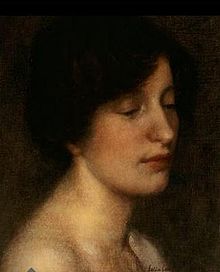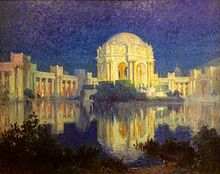Colin Campbell Cooper
Colin Campbell Cooper (born March 8, 1856 in Philadelphia , † November 6, 1937 in Santa Barbara , California ) was an American impressionist who was known for his architectural painting, especially for paintings of skyscrapers in New York City , Chicago and Philadelphia. Also for his landscape , interior and portrait painting , which he created while traveling through Europe and Asia . In addition to painting, he also worked as a teacher and writer . His first wife, Emma Lampert Cooper , was also a highly regarded painter.
Origin and education
Cooper was born in March 1856 in the city of Pennsylvania to a wealthy English - Irish family. He had four older and four younger siblings. His mother, Emily Williams Cooper, whose ancestors emigrated from Weymouth to the United States , was an amateur watercolor painter . Cooper's father, Colin Campbell Cooper, whose grandfather moved from Derry , worked as a surgeon and lawyer , and he showed a keen interest in art. Cooper discovered his interest in the arts after visiting the Centennial Exhibition . His parents supported his ambitions and encouraged him to become an artist.
In 1879, Colin Campbell Cooper enrolled at the Pennsylvania Academy of the Fine Arts to begin a three-year degree in art under the controversial painter Thomas Eakins . In 1886 Cooper made his first trip abroad to the Netherlands , Belgium and the French region of Brittany . After traveling abroad, he continued his art education at the Académie Julian in Paris from 1886 to 1890 with Henri Lucien Doucet, William-Adolphe Bouguereau and Jules Joseph Lefebvre . He also studied at the Académie Delécluse and the Académie Vitti . His apprenticeship works are mostly landscape paintings painted in a Barbizon manner . He traveled extensively throughout his life, sketching and painting scenes from Europe, Asia and the United States in watercolor and oil.
Life and work
Philadelphia and New York
Back in Philadelphia, Cooper taught watercolor and architectural painting at the Drexel Institute of Art, Science and Industry , now Drexel University, from 1895 to 1898 . Many of Cooper's paintings were destroyed in a fire at the Hazeltine Galleries in Philadelphia in 1896. As a result, relatively little of his early work exists today.
During his time at Drexel University, he spent his summers abroad, especially in the Dutch artists' colony Laren in North Holland and in Dordrecht in South Holland . Among the other artists in Dordrecht at the time, he met the renowned painter Emma Lampert Cooper from Rochester . She and Cooper were married in Rochester on June 9, 1897. In 1898 the couple returned to Europe for a few years. It was during this time that Cooper was painting architectural landmarks , he developed the Impressionist style, which he retained for the rest of his artistic career.
Cooper and his wife exhibited together in several exhibitions, including in May 1902 at the Philadelphia Art Club and in 1915 at the Memorial Art Gallery in Rochester. They moved to New York City together in 1904, where he stayed until 1921 except for many trips. Here he continued the work on his famous skyscraper paintings, which he had started about two years earlier in Philadelphia. Cooper said he was “very interested in the skyscrapers on Broad Street. It was very interesting to watch the crazy disappearance of these strange towering structures in the glory of the right kind of light ”. He said the painting that first brought him great success was Broad Street, New York , painted in 1902 ; In 1903 this painting was honored with the WT Evans Award from the New York Watercolor Club . In another interview, he said, “One of the things that impresses me most about this view of Broad Street is the dramatic contrast between the old, low-rise buildings [...] and the tall skyscrapers. My pictures are based on these contrasts. "
In 1911, The New York Times listed Cooper as the artist who best captured modern, towering structures on canvas, as "America's ultimate skyscraper artist." In an article the following year she stated that he was "one of the most interesting figures in American art" and reiterated that "he has no superior in his field." In addition to New York City, his paintings often show skyscrapers in Philadelphia and Chicago.
Cooper's painting Fifth Avenue, New York , was acquired by the French government for the Musée du Luxembourg . Such an honor was quite rare for an American artist. Critics then and now often compare the work of Cooper with that of Childe Hassam . They have often been referred to as the two most iconic artists whose paintings started a trend celebrating the wonders of the modern city, New York City in particular. Cooper presumably avoided certain subjects on purpose to differentiate himself from Hassam. Hassam, unlike Cooper, did not focus on the tall buildings in his cityscapes .
Cooper was proficient in watercolor painting as well as oil painting. He often created a small watercolor sketch before painting a larger work on the same subject in oils. But the smaller watercolors were not mere sketches for his own use; they were finished pieces that he exhibited, sometimes years earlier than the larger corresponding oil paintings he subsequently produced. Cooper was elected to a prestigious membership in the National Academy of Design in 1912.
He and his wife were on board the RMS Carpathia during their rescue mission for the survivors of the sunken RMS Titanic on April 15, 1912. He helped with the effort and during the rescue he created several paintings documenting the events. The Coopers gave up their ship's cabin so that some of the survivors had berths.
Cooper exhibited in San Francisco during the Panama-Pacific International Exposition of 1915, for which he received the gold medal for oil and the silver medal for watercolor. During this time he created a number of paintings depicting the buildings in the exhibition including the Palace of Fine Arts . He also took part in the Panama – California Exposition in San Diego in 1916. The Coopers spent the winter of 1915-1916 in Los Angeles. This time in Southern California , which was undoubtedly a key factor in Cooper's later decision to stay there permanently. His wife Emma died of tuberculosis on July 30, 1920 .
Santa Barbara
After the death of his wife, Cooper moved to Santa Barbara , California, in January 1921 . Santa Barbara was his home for the rest of his life, apart from two years in Northern Europe and Tunisia . He became the Dean of Painting at the Santa Barbara Community School of Arts.
Cooper said of his new environment, “I find Santa Barbara so conducive to the things a painter most desires - climate, flowers, mountains, ocean views, etc. - with a community interest in all kinds of artistic affairs that I come to some I am fully compensated for being isolated from this artistic universe of America. ”But he had not given up on this“ artistic universe of America ”, New York City, because he had a studio there next to the one in California for another ten years after moving .
Another aspect of his creativity became apparent from the mid-1920s, when, perhaps influenced by his father's great love for literature, he began to write plays and books. His plays were performed in theaters in Pasadena , Redlands, and Santa Fe in the 1920s and 1930s, as well as at The Strollers Theater in Santa Barbara, which he founded . In addition to plays, he wrote novels, illustrated books, and wrote an autobiography entitled In These Old Days .
In April 1927 he married his second wife in Arizona , Marie Henriette Frehsee. Cooper continued to travel and paint until his deteriorating eyesight prevented him from doing so. He died in Santa Barbara on November 6, 1937 at the age of 81. In 1938, the Faulkner Memorial Art Gallery in Santa Barbara paid tribute to Cooper's legacy by presenting a memorial exhibition of his work.
Exhibitions
Solo exhibitions (selection)
- 1924 to 1925: Fine Arts Gallery, San Diego Museum of Art
- 1925: Stendahl Art Galleries, Los Angeles
- 1927: Ainslie Galleries, Los Angeles
- 1927: Friday Morning Club, Los Angeles
- 1934: Faulkner Memorial Art Gallery, Santa Barbara
- 1938: Memorial Exhibition , Faulkner Memorial Art Gallery, Santa Barbara
- 1981: An Exhibition of Paintings by Colin Campbell Cooper , Santa Barbara
- 2003: Sullivan Goss Gallery, Santa Barbara
- 2006: East Coast / West Coast and Beyond: Colin Campbell Cooper, American Impressionist , Heckscher Museum of Art , New York City → Laguna Art Museum , Laguna Beach
- 2010: Santa Barbara Historical Museum, Santa Barbara
Web links
Individual evidence
- ^ Westphal, p. 59.
- ↑ a b Gerdts, p. 13.
- ^ A b c Colin Campbell Cooper: American Impressionist. Heckscher Museum of Art , accessed on September 14, 2017 .
- ^ A b c d e Dearinger, David Bernard: Paintings and Sculpture in the Collection of the National Academy of Design. Hudson Hills Press, Manchester, VT 1826-1925, p. 114, ISBN 1-55595-029-9
- ↑ a b Gerdts, p. 14.
- ↑ a b Stern, p. 30.
- ↑ a b Lowrey, p. 74.
- ↑ a b c Lisa Bush Hankin: Colin Campbell Cooper (1856-1937). (No longer available online.) 2007, archived from the original on July 17, 2012 ; accessed on October 6, 2017 (English). Info: The archive link was inserted automatically and has not yet been checked. Please check the original and archive link according to the instructions and then remove this notice.
- ↑ a b Hughes, p. 115.
- ↑ a b Lowrey, p. 75.
- ↑ Gerdts, p. 17.
- ↑ Gerdts, p. 18.
- ↑ Gerdts, p. 62.
- ↑ Gerdts, p. 22.
- ↑ a b The Picture That First Helped Me To Success. In: The New York Times . January 28, 1912, accessed October 9, 2017 .
- ↑ a b Westphal, p. 58.
- ↑ a b What is the Most Beautiful Spot in New York? In: The New York Times . June 18, 1911, accessed October 9, 2017 .
- ↑ Gerdts, p. 25.
- ↑ a b Westphal, p. 61.
- ↑ Gerdts, p. 38.
- ↑ Pamela Wall, Sara Arnold: Outside Perspectives: Visiting Artists In Charleston. Retrieved October 10, 2017 .
- ↑ Colin Cambell Cooper biography. In: National Museum of Wildlife Art . Archived from the original on December 22, 2010 ; accessed on October 10, 2017 (English).
- ↑ Gerdts, p. 61.
- ↑ Colin Campbell Cooper, NA. (No longer available online.) In: Sullivan Goss. Archived from the original on March 30, 2010 ; accessed on October 10, 2017 (English). Info: The archive link was inserted automatically and has not yet been checked. Please check the original and archive link according to the instructions and then remove this notice.
- ^ Rome Aids Titanic Fund. In: The New York Times . May 12, 1912, accessed October 10, 2017 .
- ↑ Emma Lampert Cooper. In: University of Rochester . Retrieved October 10, 2017 .
- ↑ a b c Gerdts, p. 103.
- ^ Westphal, p. 62.
- ↑ Colin Campbell Cooper. In: Stern Fine Arts. Retrieved October 10, 2017 .
- ↑ Gerdts, p. 121.
- ↑ Colin Campbell Cooper: sudies, Drawings, And Small Works. In: Sullivan Goss. 2003, accessed on October 10, 2017 .
| personal data | |
|---|---|
| SURNAME | Cooper, Colin Campbell |
| BRIEF DESCRIPTION | American impressionist painter |
| DATE OF BIRTH | March 8, 1856 |
| PLACE OF BIRTH | Philadelphia |
| DATE OF DEATH | November 6, 1937 |
| Place of death | Santa Barbara , California |







